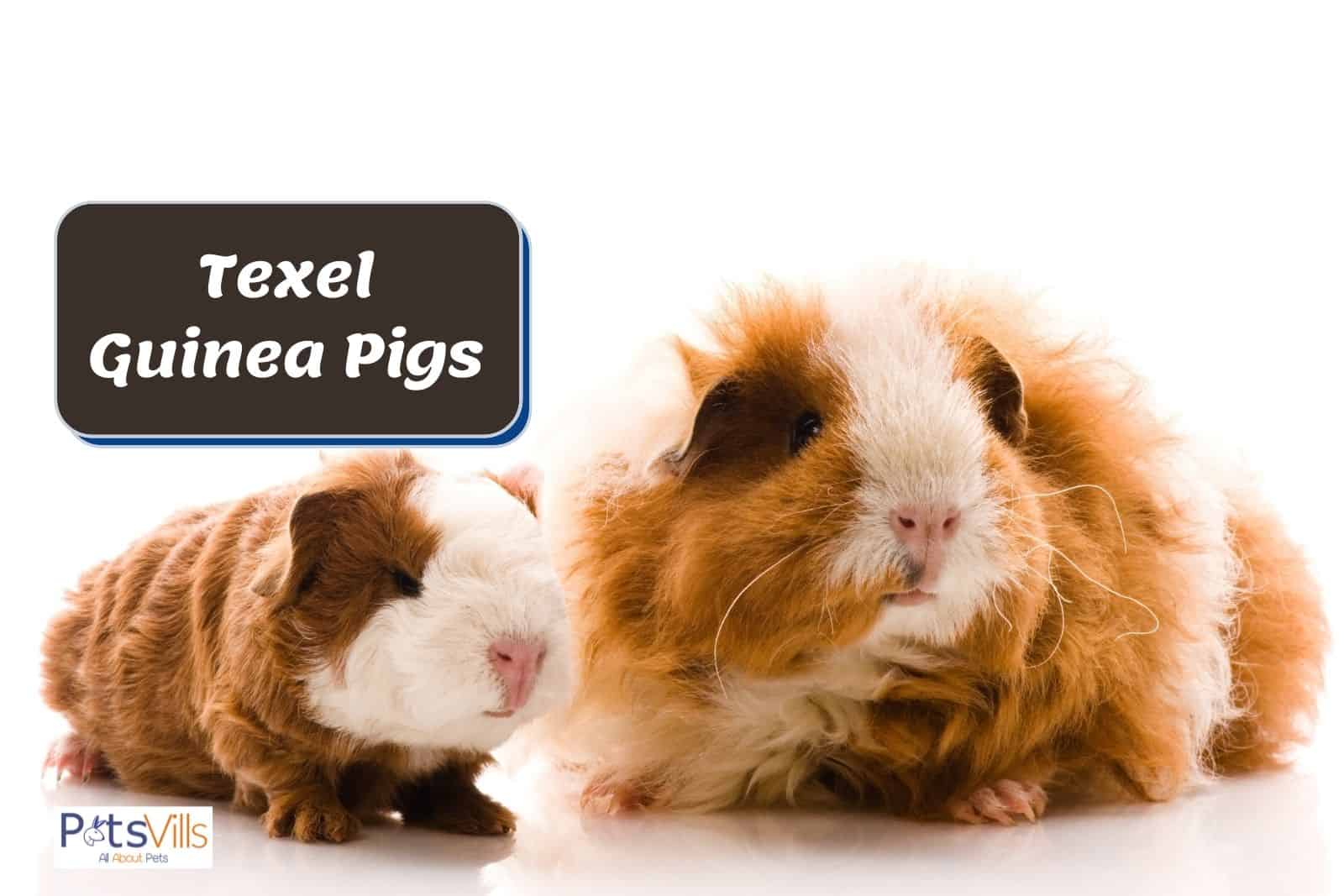Have you ever heard of a Texel guinea pig?
They’re one of the newest guinea pig breeds that are slowly gaining popularity these days.
They have become so popular in recent years that they are becoming harder to find due to an increase in demand.
Read on and get to know more about these lovely creatures to see if they are actually a fit for you and your home.
Don’t forget to also check our guinea pig breed list!
Table of Contents
Texel Guinea Pig Breed History
The Texel Guinea Pig is a crossbreed of a Silkie Guinea Pig and a Rex Guinea Pig that was first established in England in the 1980s.
Several crossbreeding from different breeds of guinea pig have further enhanced the Texel to what it is, and it has been recognized officially as a Guinea Pig breed by the American Cavy Breeders Association in 1988.
Texel Guinea Pig Characteristics
Guinea pigs, or cavies, come in different breeds.
There are the hairless guinea pigs, like the Baldwin guinea pigs, the short-haired ones like the American Guinea Pig, and then you have the long-haired guinea pigs, like the Texel ones.
Texel cavies are fast becoming one of the more popular guinea pig breeds due to their unique look.
Unlike their other cavy cousins, this breed of guinea pig has physical characteristics that set them apart which may account for their growing demand.
Texel Guinea Pig Physical Characteristics
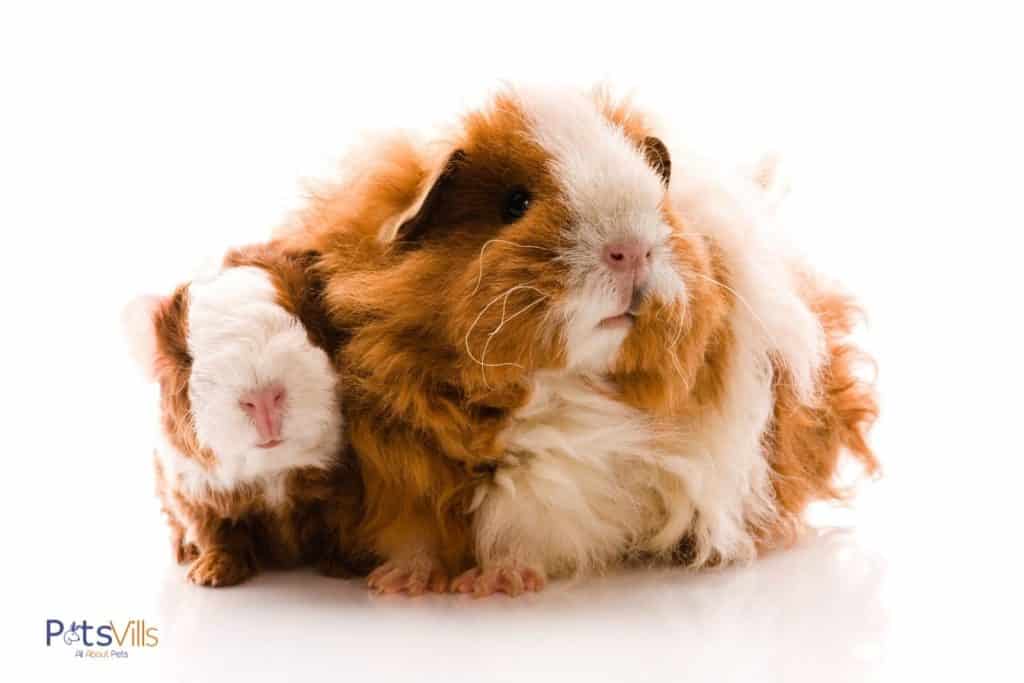
Texel cavies belong to a breed of long-haired guinea pigs. This cavy breed looks quite similar to its other long-haired cousin, the Silkea Guinea Pig, although Texels have curly coats covering their entire body instead of straight hair.
This curly hair of theirs has actually earned them the nickname Curlies, as well as the reputation of being curly guinea pigs.
This breed of cavy has a broad body, but is comparatively shorter compared to any other common guinea pig breed.
Despite their shorter body, they may still grow up to anywhere between 8-10 inches in length with the males being slightly longer than the females.
Depending on their diet and activity, they may weigh anywhere from 1.5 to 2.5 pounds.
There can be a wide variety of color combinations when it comes to the Texel’s coat and it all really depends on cavy genetics as to what combinations may come out.
READ MORE: Rex Guinea Pig Personality
Texel Personality and Temperament
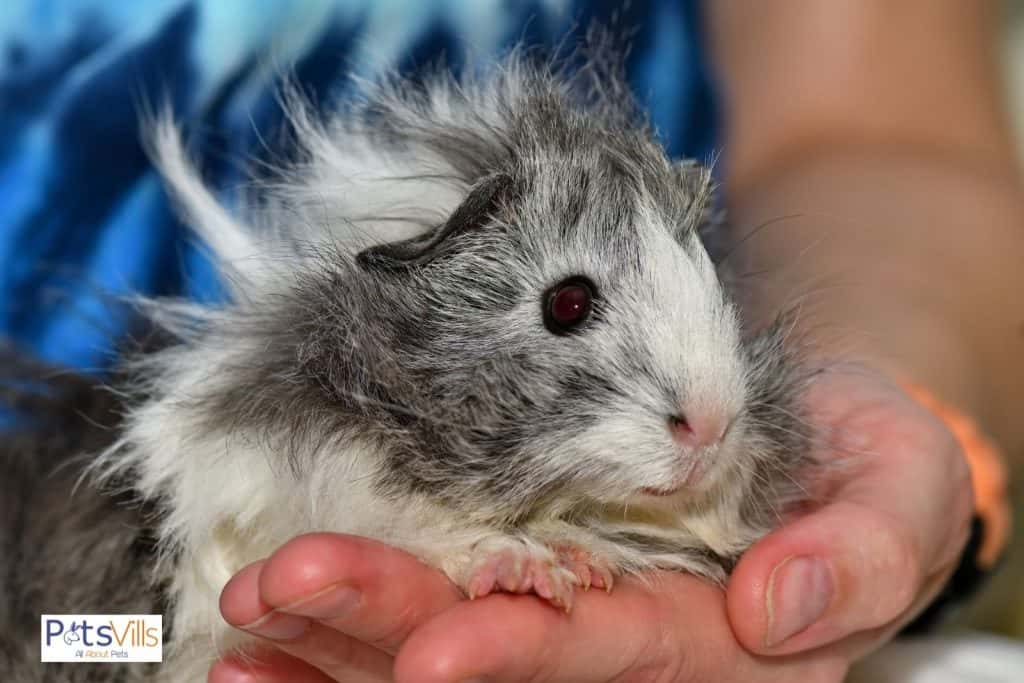
Texel cavies are pretty much like all other guinea pig breeds. They carry with them a calm and tranquil demeanor.
They are also social animals that can easily get used to any pet owner once they are exposed at a young age.
Compared to piggies with shorter hairs, they are quieter but they do carry with them an occasional playful and mischievous streak.
Texel Pig Baby
Texel pig babies, otherwise known as pups, are born complete with hair and teeth. This is, in fact, a common trait for all guinea pig pups, regardless of breed. They are able to see and hear from the moment they are born.
Their digestive system matures pretty fast too considering that they are able to eat solid food after 24 hours from the time of birth.
Despite this, they still will need to nurse up to around six weeks.
During this time, the Texel pig mom identifies her pup through their scent so make sure that you don’t touch them so often so the mom doesn’t start rejecting them before the six weeks ends.
Texel pig pups, just like any other guinea pig pups, are able to communicate early on. So don’t be surprised to hear squeaks and make sure that you listen to them.
Squeaks are usually a sign of stress for these pups so being aware of this will help you in caring for these newborns as well.
Here’s how you can bond with your guinea pig.
Texel Guinea Pig Health and Care
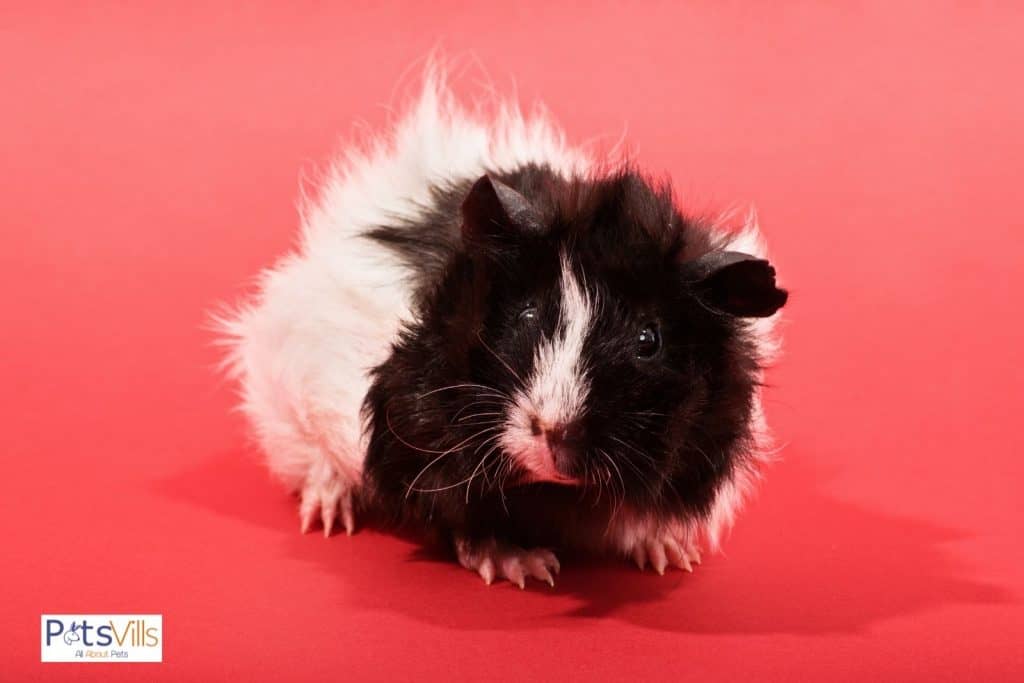
Having a Texel cavy as a pet means that you would want to make sure that it is strong and healthy.
Healthy Texels, being long-haired guinea pig breeds, are supposed to have a coat of hair that is curly, yet glossy. They are also expected to be alert and agile, even when in their cages.
They should be in a weight range that is healthy without having any show of bone, especially along the rib area. They should be free of bumps and sores as well since these can be signs of skin irritation, infection, or even worse, any severe disease.
There are things to look out for when caring for your Texel and there are certain health issues that you may want to look out for.
Texel Guinea Pig Breed Diet
There is no special dietary requirement for Texel cavies, except for vitamin C to be added to their water on a daily basis. Cavies aren’t capable of producing their own vitamin C so it is important for you to add this as a supplement to their drinking water.
Make sure that you provide your cavy with clean water every day. Other than that, they can be fed with hay, fruits and veggies, and guinea pig pellets as well.
Grass hay, in fact, is what should make up the bulk of their diet as well as green, leafy veggies. Try to avoid root crops, and even carrots, as they may cause digestive problems, such as diarrhea, for your Texel.
Fruits and snacks are considered as treats since they can easily make your pet Texel grow fat.
Cucumber is a pretty good snack for your Texel since the water content can keep them hydrated, especially during hot days.
You want to keep them healthy since obesity can cause them a number of health problems, especially when they start to age.
Texels should be fed at least twice a day. Avoid overfeeding them since this, again, may cause them to gain too much weight.
Remember that keeping them within a healthy weight range will help them avoid getting sick in the future.
Texel Cage and Beddings
The best type of guinea pig cage is one that you can assemble yourself. This can be made from materials you can purchase anywhere: corrugated boards, cable ties, cube grids, and standard connectors.
For beddings, you can use liners made from fleece, aspen wood shavings, or any other kind of paper-based beddings.
Texel Guinea Pig Breed Grooming
Guinea pigs are generally low maintenance as compared to other pets. They do not need regular baths since they have an intense dislike of water and they actually are accustomed to grooming themselves.
Texel guinea pig care, however, is a bit more challenging, because of their curly coats.
Regular grooming and brushing are needed by Texels because they end up with tangled and matted hair if they are not brushed on a daily basis.
Knotted hair is a common problem for any longhaired breed of guinea pig and Texels are not an exception to this. Tangled hair can be a nest for lice and mites which may cause problems later on.
You’ll want to make sure that keeping your piggy well-groomed becomes part of a regular routine.
Combing and Brushing
In order to convince your haired cavy to sit on your lap and have its hair combed, you can try putting some lettuce or cucumber slice on your lap to entice him to sit there.
You can start combing your cavy using a bristle brush. Make sure to always follow the direction of your pet’s hair when combing it.
Once you detangle your cavy’s hair, you can shift to a soft brush to smoothen the coat of your cavy.
Your little cavy may initially resist having his hair combed and brushed but it will develop a liking to it in time as it gets used to this routine.
Bathing
Your Texel likes to keep himself clean so bathing him is not really a necessary routine. However, there may be occasions when he gets a bit dirty or even smelly.
In this case, you will have to give him a bit of a bath to freshen him up a bit. Before giving him a bath, make sure that you have everything ready.
Make sure that you have a basin, some small pet shampoo that you can get from pet stores a soft, dry towel, and a hairdryer.
Fill the basin with around 1/4 inch of lukewarm water to make sure that your Texel doesn’t feel cold. Slowly dip your Texel into the water starting with his hind feet.
After slowly putting him on the basin, use your hands to slowly pour water onto his body.
Once wet, you can remove him from the basin and put him on the floor or any flat surface. Make sure that you have a towel on the flat surface so you don’t get wet.
You can start shampooing your pet guinea to clean him up and rinse him right after. Towel dry your guinea pig right after to make sure he doesn’t get cold.
Piggies aren’t capable of maintaining their body temperature so they easily get cold. You can use a hairdryer to completely dry your piggy, but make sure that you use the lowest setting so you don’t end up burning your piggy.
Ear Cleaning
Your piggy’s ears need to be regularly cleaned in so that wax doesn’t build up in them. Mites also tend to hide in piggy ears so keeping them clean also means that their ears get regularly checked.
You can do so by using a cotton swab to clean the outer portion of your piggy’s ears. Do not insert the swab into their ears since this may damage them.
Nail Trimming
You’ll need to trim your Texel’s nails every now and then since long nails will make it difficult for them to walk and move around. You’ll know when it’s time to cut their nails when they start to curl at the tips.
Do take note that piggies aren’t really enthusiastic about having their nails cut so you have to be very patient when doing this.
Cut only a very small portion at the tip, making sure that you avoid the quick. Accidentally cutting the quick can injure your piggy. The quick is the pink or reddish portion on your piggy’s nails.
For Texels with darker colored nails, this may be difficult to locate though. In this case, you can try cutting not more than 1/4 inch from the tip to make sure you don’t reach the quick.
Take a look at this cute texel guinea pig:
Texel Guinea Pig Breed Health Issues
Taking care of your guinea pig will keep them far away from disease and health problems.
They may, however, still get sick. Being observant and being aware of signs concerning your piggy’s health will help you easily address these health problems before they worsen.
Eye infection
A condition known as entropion is common in Texels, even at a young age. This can be caused by their long eyelashes entering their eyes and becoming a source of irritation.
Signs of entropion are cloudiness in the eyes, redness, the presence of discharge, and frequent scratching.
Antibiotic eye drops can easily solve this problem. It would be best to address eye infections early on. If an eye infection worsens, your cavy may need surgery in order to correct the problem.
Digestive and bladder issues
Texel cavies are quite prone to a number of issues when it comes to their digestive system. Among these are diarrhea, bladder infection, and bladder stones.
The best way to avoid this is to provide a lot of grass and hay to your guineas to aid their digestion.
Veggies like cauliflower, broccoli, and cabbage may cause gas and bloat to your Texels so be sure to give it to them only on occasion.
Tooth problems
Texel guineas, just like other breed variations, can suffer from a number of tooth problems.
The teeth of guinea pigs elongate as they grow old. So it is important that they keep on chewing and gnawing in order to keep those teeth short.
Giving them adequate amounts of hay will help keep their teeth short. Chew toys, or even tree branches, can help control the growth of their teeth.
If your cavy gets a broken or lost tooth, it can usually grow a new one if your cavy is healthy enough. This, however, can be a sign of lack of vitamin C.
Make sure that you always supplement your cavy with vitamin C in your diet in order to avoid this problem.
Your Texel’s teeth may also get elongated roots. If you feel any bumps along his lower jaw, chances are the roots of his teeth are getting longer. In this case, have a vet check him out so he can correct the problem.
Texel Guinea Pig Life Span
If well taken care of, a Texel guinea pig can live anywhere from five to ten years.
Where Can I Buy a Texel Guinea Pig?
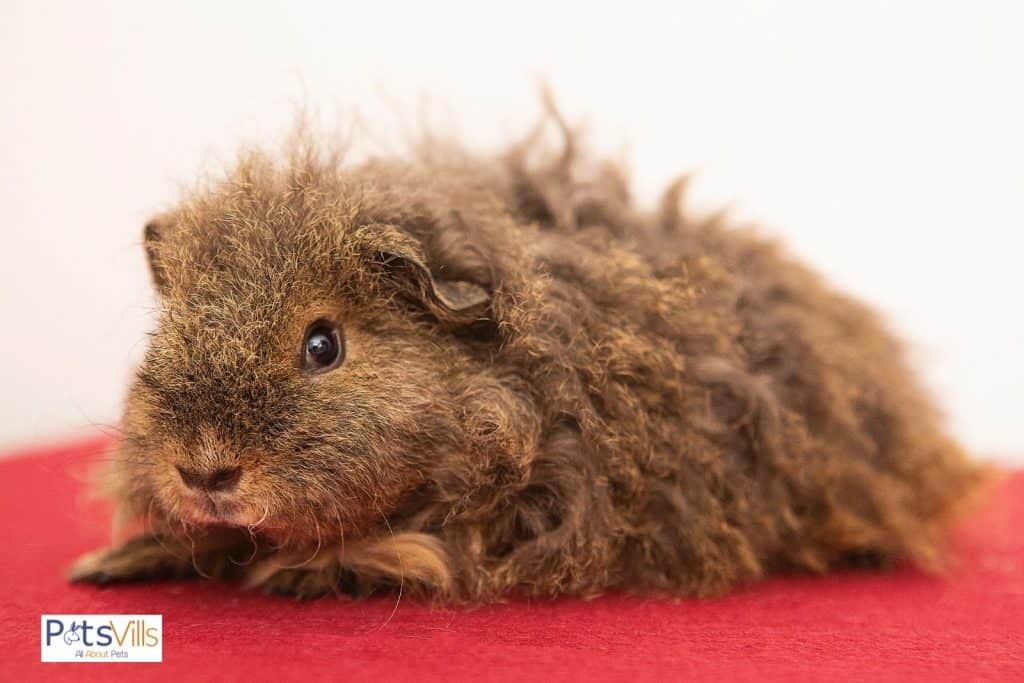
You can get a Texel guinea pig from either a pet store or a breeder.
Pet stores though are usually guinea pig mills and there are those that don’t use best practices when raising the piggies.
You can also check out adoption sites. This would probably be the best thing to do if you plan on getting a Texel guinea.
How Much is a Texel guinea pig?
Texel guinea pigs can cost anywhere from $20 to $75 dollars. Due to an increase in their popularity, the price of Texel guinea pigs has increased in the past couple of years.
Texel Guinea Pig Breeders in US
The American Cavy Breeders Association is home to many Texel cavy breeders. To be sure that you do get quality cavies, it would be best to take note of certain things when choosing a breeder.
- Choose one who lives within or close to the area where you live.
- Check out the breeding facility yourself in order to know how his cavies are taken care of.
- Do your research and ask the breeder questions. A good breeder will know his stuff and not hesitate to answer any questions you may have in mind.
- Check blogs and forums that may have more information about the breeder you have in mind. Check for feedback and reviews since they can give you some insight about the breeder you plan to purchase your cavy from.
FAQs
What is the difference between a Merino and Texel guinea pig?
Although both these cavies are curly-hair breeds, the Merino can be distinguished by a crest on his head.
What is the difference between an Alpaca and Texel guinea pig?
Alpaca and Texel guinea pigs are often mistaken for each other due to the similarities in their physical characteristics. Alpaca guineas, however, have bangs that tend to swoop forward unlike Texel guinea pigs, whose bangs tend to go backward.
Are Texel guinea pigs friendly?
Texel guinea pigs are social animals when they are trained to be so at an early age. They can be very friendly and they can easily adjust to other guinea pigs and to their adopted humans as well.
Do Texel guinea pigs need haircuts?
As long as you keep your Texel guinea’s hair groomed and combed, they won’t need to have haircuts at all.
Conclusion
Texel guinea pigs are sociable and friendly animals that make perfect pets. They do, however, require regular grooming which may take some amount of time on your part.
However, if you consider this as bonding time for you and your pet instead of a tedious chore, you may actually get to enjoy having a Texel guinea pig as part of your home and your family.
References
- Clark, Tanya. 2019. “Your Baby Guinea Pig – What to Expect and How to Look after Them.” Squeaks and Nibbles. November 25, 2019. https://squeaksandnibbles.com/baby-guinea-pig/.
- Hess, Laurie. 2018. “9 Breeds of Long-Haired Guinea Pigs with Amazing Manes.” Petmd.com. PetMD. October 31, 2018. https://www.petmd.com/exotic/9-breeds-long-haired-guinea-pigs-amazing-manes.
- “What Is a Texel Guinea Pig?” 2020. Vet Explains Pets. June 10, 2020. https://vetexplainspets.com/texel-guinea-pig/.
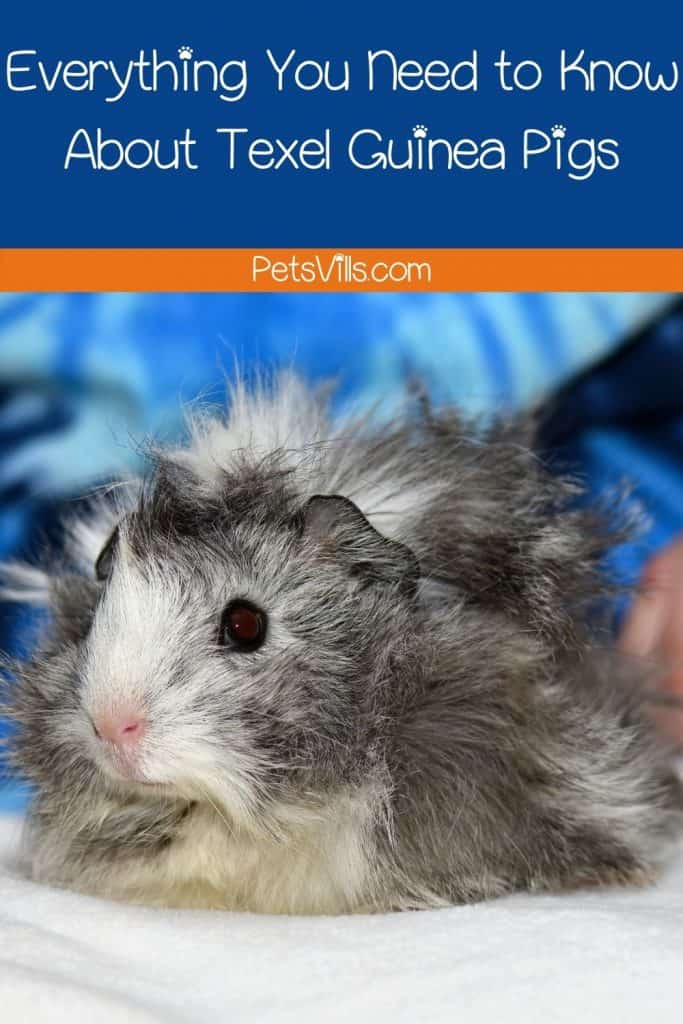
Alina Hartley is a small-town girl with a ginormous love of bearded dragons. It all started with Winchester, a baby bearded who was abandoned at the shelter by his former owners because of a birth defect that caused one front leg to be shorter than the other. Alina originally went to the shelter looking for a guinea pig, but one look at Winchester and it was love at first sight. From that day on, Alina has dedicated her life to learning everything she can about bearded dragons. She loves helping new beardie parents start their incredible journey with these magnificent reptiles.
Follow her on:
LINKEDIN
TWITTER.
Read her latest articles HERE
Learn more about her HERE.

